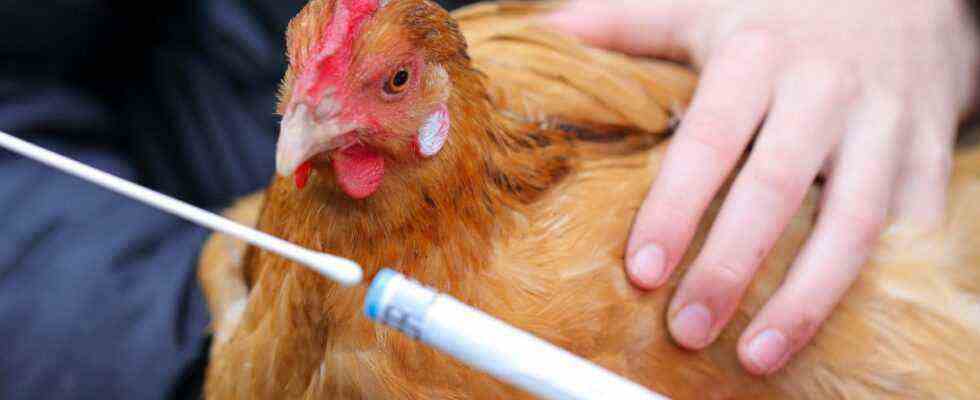While mankind is struggling with the corona variant Omicron, another virus is spreading rapidly among birds, almost unnoticed: an avian flu pathogen of the H5N1 type. There have never been so many cases in Germany as this winter. Hundreds of wild birds have been found dead from bird flu since early October. There have also been more than 50 outbreaks in poultry farms. That’s almost twice as many cases as in the same period last year, says Thomas Mettenleiter, President of the Friedrich Loeffler Institute.
New cases are added every day, and there is no sign of the epidemic abating: The winter is still long and, like the Sars-CoV-2 coronavirus, the bird flu pathogen also tends to build up in waves during the cold season. That was also the case in other years, but the increase has never been as steep as it is now. Why is that?
The virus may now remain in Germany forever
Mettenleiter fears that something fundamental has changed: “In previous years, it was always the case that the pathogen was no longer detected in central and northern Europe in the summer,” he says. In autumn it was then reintroduced by migratory birds. It was different last summer: “We have to assume that the pathogen has not completely disappeared, at least from Northern Europe,” says Mettenleiter. For the first time in 2021, wild birds that died from bird flu were also found in the warm season. This indicates that the virus has recently “summered” with us.
According to Mettenleiter, the unusually high number of cases this year could be due to the fact that the virus was not introduced to Germany as usual, but was already there. Therefore, the pathogen was probably able to strike immediately and spread faster than usual when conditions were favorable for it in the fall. Among the first victims were gray geese and barnacle geese, among which there was a massive death on the Schleswig-Holstein North Sea coast in autumn. A short time later, the first cases occurred in poultry, which is usually infected through the faeces of infected wild birds. However, the pathogen can also be brought into stables by people, for example if shoes or clothing are contaminated. The feed or water for the animals are also possible sources of infection. “The virus finds the gap,” says Mettenleiter.
Now we have to wait and see how the situation develops next summer. If the bird flu virus can also be detected in wild geese, wild ducks, swans or seagulls, it would mean that bird flu has become endemic. Or to put it more correctly: “enzootic”, after all it is an animal disease. With Sars-CoV-2, it would be progress if the virus became endemic. This means that the pathogen is always there and will not go away. But the number of diseases would no longer increase over time. About the same number of people would get sick every year. In the case of the bird flu pathogen, which has so far only been a problem in Germany in the winter months, this situation would be a step backwards.
Infected ducks stagger around aimlessly
H5N1 would then probably first spread further among wild birds. This would increase the probability of farm poultry also becoming infected enormously. “We would then have an infection pressure from the wild bird population on our poultry all year round,” says Mettenleiter. “That would be a significantly different situation than we have actually had in the entire documented history.”
If some turkeys or chickens, geese or ducks die from bird flu in a barn, all the other animals must also be killed immediately and disposed of in the carcass disposal. Otherwise the virus would continue to rage. Turkeys and chickens are particularly susceptible, for the bird flu virus is almost always fatal. First, the pathogen infects the respiratory tract, then it spreads throughout the animal’s body. The brain is also affected, especially in ducks and geese. The animals then stagger around disoriented until they can no longer stand on their feet.
If the bird flu virus actually stays in Germany forever in the future, the consequences for the keeping of productive poultry would be significant: The stables would have to be built differently than before, for example covered, so that no droppings from wild birds can fall into them. Mettenleiter says that we will probably have to think about reducing the density of stocks, at least in certain regions. The locations of livestock farms are also up for debate: “From our point of view, it does not make much sense to place livestock farms in areas that are particularly frequented by wild birds,” says Mettenleiter – wetlands, for example.
In rare cases, people are also infected with bird flu. Recently, for example, a Briton who had close contact with infected birds. “We have to assume that the highly pathogenic avian influenza viruses basically have zoonotic potential,” says Mettenleiter. That means they can theoretically jump from animals to humans. With the pathogen currently rampant in Germany, however, this potential is very low. Like the bird flu virus that was rampant in Germany in 2006, it is an H5N1 virus. For humans, however, the current virus is much less dangerous than the pathogen from back then.
At that time, no one in Germany was infected with the more dangerous H5N1 virus, which first infected a human in Hong Kong in 1997. It was known that the pathogen had reached Germany in 2006 because it had been detected in wild birds. However, almost a thousand people worldwide were infected with the aggressive virus – more than half of them died.
In contrast to the corona virus today, the bird flu virus never learned to spread among humans. Almost all patients have been infected through contact with infected birds. Had it been otherwise, there might have been a pandemic as early as the early 2000s.

